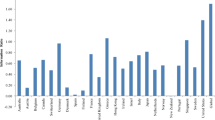Abstract
We propose a new continuous-time contracting model, in which the firm value process can only be observed with noise, and there are two sources of moral hazard: the agent’s effort and misvaluation. The principal can induce the agent to alter the perceived fundamental value of the firm through misvaluation, thus changing the market estimate of that value. We consider two cases in detail: the one in which the market correctly anticipates only the effort, and the other in which it correctly anticipates both the effort and the amount of misvaluation. In the first case, we find that it is optimal for the principal to induce the agent to apply a non-zero amount of misvaluation. Using calculus of variation techniques, we find the optimal pay-per-performance sensitivity (PPS) of the contract and optimal effort and misvaluation amount, by means of solving of a second order ordinary differential equation. In the second case, which can be viewed as an extension of the seminal Holmstrom-Milgrom model to the case of noisy observations, we find that the optimal misvaluation value is zero, and we compare the resulting optimal contract to the Holmstrom-Milgrom contract.
Similar content being viewed by others
References
Auzinger, W., Kneisl, G., Koch, O., Weinmuller, E.: SBVP 1.0—A MATLAB Solver for Singular Boundary Value Problems, Technical Report, Vienna University of Technology, 2011
Balsam S., Bartov E., Marquardt C.: Accrual management, investor sophistication, and equity valuation: evidence from 10-Q filings. J. Account. Res. 40(4), 987–1012 (2002)
Biais B., Mariotti T., Plantin G., Rochet J.-C.: Dynamic security design: convergence to continuous time and asset pricing implications. Rev. Econ. Stud. 74(2), 345–390 (2007)
Cadenillas A., Cvitanić J., Zapatero F.: Optimal risk-sharing with effort and project choice. J. Econ. Theory 133, 403–440 (2007)
Capponi A., Cvitanić J.: Credit risk modeling with misreporting and incomplete information. Int. J. Theor. Appl. Financ. 12, 81–112 (2009)
Capponi, A., Cvitanić, J., Yolcu, T.: A variational approach to contracting under imperfect observations. SIAM J. Financ. Math. (2012)
Clarke, F.H.: Methods of Dynamics and Nonsmooth Optimization, vol. 57, pp. 30–40. Capital city press, Montpelier, Vermont (1989)
Cvitanić J., Zhang J.: Optimal compensation with adverse selection and dynamic actions. Math. Financ. Econ. 1, 21–55 (2007)
Cvitanić J., Wan X., Zhang J.: Optimal compensation with hidden action and lump-sum payment in a continuous-time model. Appl. Math. Optim. 59, 99–146 (2009)
DeMarzo P.M., Sannikov Y.: Optimal security design and dynamic capital structure in a continuous-time agency model. J. Financ. 61, 2681–2724 (2006)
Duffie D., Lando D.: Term structure of credit spreads with incomplete accounting information. Econometrica 63, 633–664 (2001)
Ferrarin, G., Giudici, P.: Financial scandals and the role of private enforcement: the Parmalat case. ECGI Law Working Paper 40, 2005
Gibbons, R.: Lecture Note 1: Agency Theory. Preprint available at http://web.mit.edu/rgibbons/www/903LN1S10.pdf, 2010
Holmstrom B., Milgrom P.: Aggregation and linearity in the provision of intertemporal incentives. Econometrica 55(2), 303–328 (1987)
Jensen, M.: Agency costs of overvalued equity. Financ. Manag. 34(1) (2005)
Liptser R.S., Shiryaev A.N.: Statistics of Random Processes II. Applications. Springer, New York (2000)
Müller H.: The first-best sharing rule in the continuous-time principal-agent problem with exponential utility. J. Econ. Theory 79, 276–280 (1998)
Ou-Yang H.: An equilibrium model of asset pricing and moral hazard. Rev. Financ. Stud. 18, 1253–1303 (2005)
Schättler H., Sung J.: The first-order approach to continuous-time principal-agent problem with exponential utility. J. Econ. Theory 61, 331–371 (1993)
Schättler H., Sung J.: On optimal sharing rules in discrete and continuous-times principal-agent problems with exponential utility. J. Econ. Dyn. Control 21, 551–574 (1997)
Sung J.: Linearity with project selection and controllable diffusion rate in continuous-time principal-agent problems. Rand. J. Econ. 26, 720–743 (1995)
Sung J.: Corporate insurance and managerial incentives. J. Econ. Theory 74, 297–332 (1997)
Tonelli, L.: Sur une mithode directe du calcd des variations. Rend. Circ. Mat. Palermo 39 (1915)
Author information
Authors and Affiliations
Corresponding author
Rights and permissions
About this article
Cite this article
Capponi, A., Cvitanić, J. & Yolcu, T. Optimal contracting with effort and misvaluation. Math Finan Econ 7, 93–128 (2013). https://doi.org/10.1007/s11579-012-0088-z
Received:
Accepted:
Published:
Issue Date:
DOI: https://doi.org/10.1007/s11579-012-0088-z




